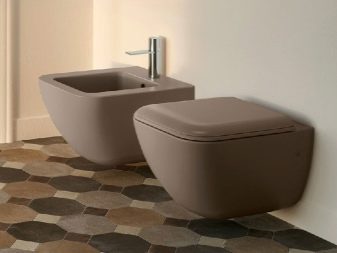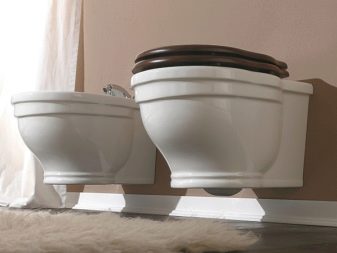Wall-hung bidet
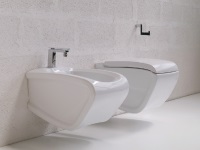
If you're going to install a bidet in the bathroom, you have to choose between a floor-standing and a built-in version. What are the advantages of a wall-hung bidet, how to choose it and what should be considered when installing?
Advantages
If we compare this version of the bidet with a floor bidet, you can note the following advantages:
- The built-in bidet is unpretentious in use, quiet and reliable.
- Thanks to the hidden installation of communications in your room will not be visible taps and pipes, so the interior of the room is not affected. The bidet is placed close to the wall, so you will not notice the pipes that come up to it.
- Since such a bidet will protrude less due to its design, such sanitary ware will save space in your bathroom. This will be especially appreciated by owners of small spaces.
- Cleaning in the bathroom with a hanging bidet is much easier. You will be able to clean the room without any obstacles, since the bidet is not connected to the floor.
- Under the freed space at the bottom of the bidet, you can make a cabinet for various small things.
- Installation of this type of bidet is quite simple. It is quite possible to cope with it yourself.
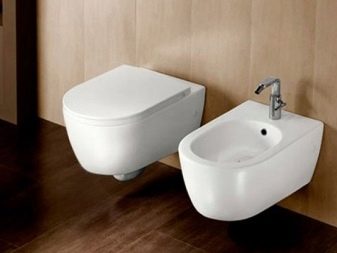
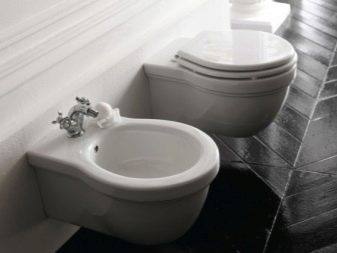
Disadvantages
The disadvantage of the built-in version of the bidet can be called only the cost of such plumbing. It is much higher than the price of the floor bidet. In addition, some people are not psychologically ready for the wall-hung plumbing, considering it less durable, although in fact, the suspended model of the bidet can withstand the weight up to 400 kilograms.

Design
In the construction of the wall-hung bidet, there are two parts:
- The installation, which is connected to the wall;
- Bowl, which is mounted on it using studs.
Installation is called a supporting frame, which serves as a support for the bowl and contains all the equipment for the bidet operation. By varying the height of the installation, the bidet can be adapted to the height of the users. The design of the bowl can include both a special faucet (this makes it similar to a sanitary shower), and electronic components.

Popular Brands
Roca
This Spanish manufacturer of sanitary ware is quite a well-known company of the bathroom products market. Thanks to its beautiful shapes and high quality products the brand is in high demand. Roca bidets are available both in the medium price category and in the luxury class. They are equipped with a special mechanism for economical water consumption.
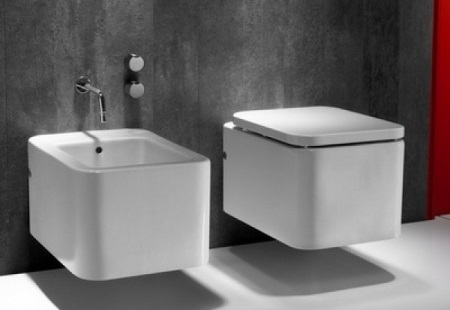
Ideal standard
The main features of sanitary ware of the German manufacturer are elegant forms, naturalness and high quality materials, minimalism, ease of use. Bides from Ideal standard attract with its design and functionality.
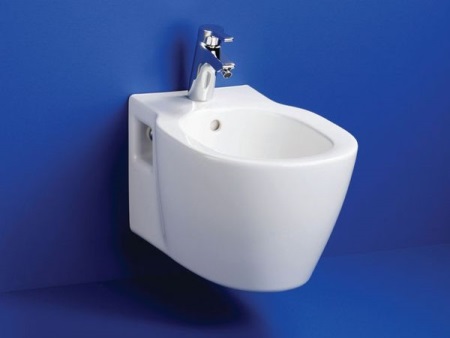
Cersanit .
Products of this European brand are in demand due to their classic forms, laconic design and high-quality execution. The company produces a series of bidets and toilets for small bathrooms. Such devices are distinguished by an interesting form and high comfort of use.

Tips for choosing
- First, decide what material your bidet will be made of. The main materials used to manufacture such sanitary devices are earthenware and porcelain. They are very similar in appearance, especially if the glaze on their surface is of high quality. At the same time porcelain bidets are more expensive, since this material has a more expensive production technology and higher quality (porosity and hygroscopicity are lower, so unpleasant odors and dirt are absorbed in this material less).
- Next, choose the design of the bidet, based on the features of your sewer riser. Outlet device (horizontal, vertical or oblique) must match the supply sewer.
- Most often, the bidet is chosen in conjunction with the toilet, so that both sanitary devices look harmoniously in the interior of the room.
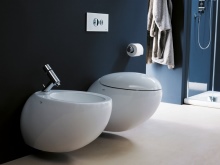
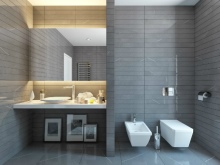
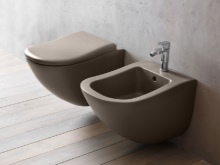
What faucet is suitable?
The faucet for the suspended version of the bidet will be slightly different than for the floor model. It is also different from conventional faucets for the sink. This faucet is a movable device that allows you to direct the water jet in the desired direction. In addition, bidet faucets have a perlator, which increases the accuracy of the jet (it also softens it).
Modern models of faucets allow adding air to the stream of water, so that it is possible to make the water stream harder or softer. Some mixer taps have a pulsating water jet option. Faucets are also available with sensors that respond to human proximity.
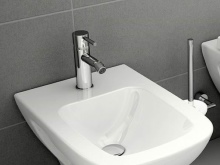
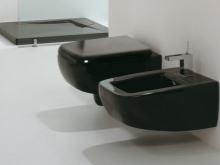
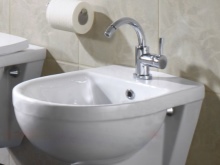
Placement tips
Determine exactly where the bidet will be located in the bathroom, it is necessary even before buying the device. Often such sanitary ware is placed next to the toilet.
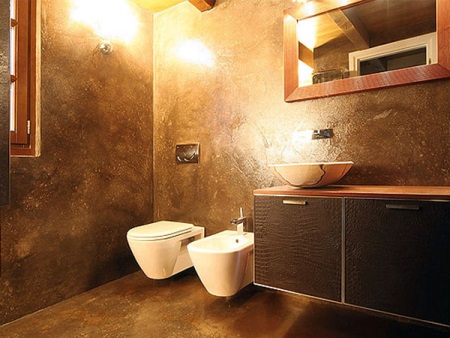
Choosing a suitable bidet model, calculate whether it will fit in your bathroom and whether there will be enough free space to move around the room. In front of the bidet should be about 60-70 cm of free space, and between the bidet and the toilet is optimal distance of 25 cm.
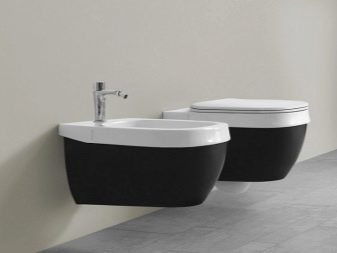
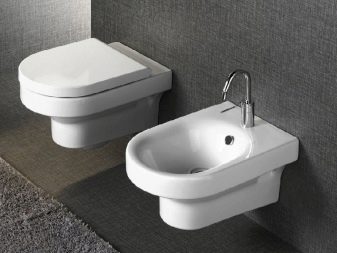
Installing
First prepare for work wrenches, screwdrivers, silicone sealant, adjustable wrench, mounting tape, drill or punch. The first step in the installation of the wall-hung bidet will be the preparation of the niche. In the wall in the selected location create a recess, corresponding to the size of the installation. To the center of this hole bring water pipes and sewage. You do not need to finish the niche inside, because it will be hidden under the drywall.
The next step involves the installation of the installation. It is attached in two places to the floor and with the help of two brackets to the wall. It is important to install the carrier frame strictly vertically and securely fix it with the fasteners provided by the manufacturer. Additional pouring of the installation with concrete is not recommended, as it will slightly increase the strength, but will create problems if you need to repair and dismantle the structure.
After making sure that the mounting fasteners of the installation are tightened, connect its outlet to the sewer, and then screw in the studs. At the same time, you should be careful and choose the 2 threaded holes that match your bowl, because the installation has 4 holes that fit 2 standard sizes of bowls. The studs should be secured with locknuts, after which the niche can be covered with drywall.
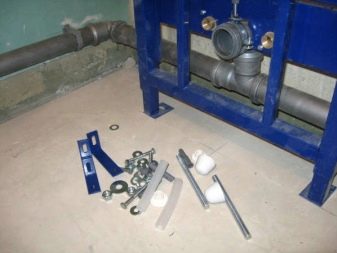
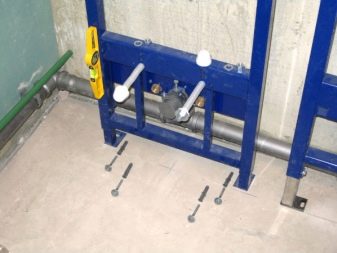
Facing the walls of the bathroom, the bowl is attached to the installation and connect the device to the water supply. Here is important to be careful, because the mixer hoses will be located hidden, and in case of possible deficiencies will have to dismantle the bowl. In the connection to the sewer is used a special spigot, which has rubber seals. Select the length of this spigot correctly, because too long will give you trouble when connecting the bidet to the wall, and too short can cause leaks.
When fixing the bowl, consider these points:
- It is important to have a gasket of silicone or rubber between the bowl and the wall. It will act as a buffer that protects the tub liner from destruction and reduces the load on the studs.
- If the gasket is not included with the bidet, apply regular silicone from a tube to the base of the bowl all around its perimeter. Proceed to the installation of the bowl after it dries.
- Tightening the nuts, try to find the golden mean. Tightening them with excessive force, you can cause the deflection of the tile and drywall. If the nuts are loosely tightened, your bidet will become dangling.
